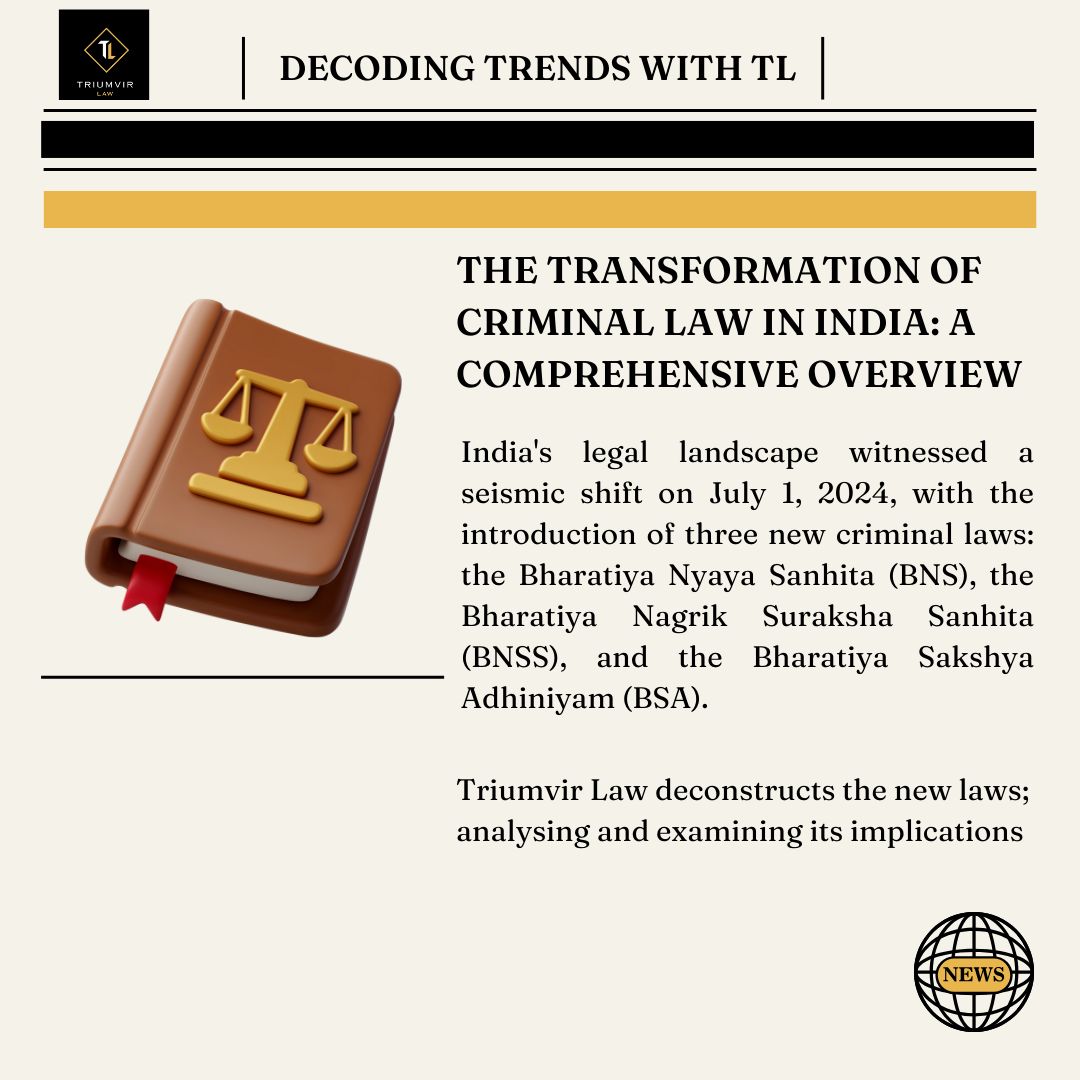
Decoding Trends With Trumvir Law

The Transformation of Criminal Law in India: A Comprehensive Overview
- July 20, 2024
- Blog
- Disputes Practice Team
India’s legal landscape witnessed a seismic shift on July 1, 2024, with the introduction of three new criminal laws: the Bharatiya Nyaya Sanhita (BNS), the Bharatiya Nagrik Suraksha Sanhita (BNSS), and the Bharatiya Sakshya Adhiniyam (BSA). These laws replace the long-standing Indian Penal Code (IPC) of 1860, the Criminal Procedure Code (CrPC) of 1973, and the Indian Evidence Act of 1872, respectively. This article delves into the details and implications of these new laws, providing a thorough analysis of their provisions, objectives, and anticipated impact on India’s criminal justice system.
Introduction of New Criminal Laws
Bharatiya Nyaya Sanhita (BNS)
The Bharatiya Nyaya Sanhita replaces the Indian Penal Code (IPC) with a more modern and comprehensive framework comprising 358 sections. This new code introduces 20 new crimes, increases penalties for 33 offenses, enhances fines in 83 crimes, and includes a dedicated chapter on crimes against women and children. Key highlights include the introduction of community service as an alternative punishment for certain minor offenses and the mandatory collection of forensic evidence during investigations.
Bharatiya Nagrik Suraksha Sanhita (BNSS)
Replacing the Criminal Procedure Code (CrPC), the BNSS encompasses 531 sections, incorporating 44 new provisions aimed at expediting legal processes. Notable changes include the formalization of Zero FIRs, which can be registered at any police station irrespective of jurisdiction, and the inclusion of electronic modes for filing FIRs. The BNSS also emphasizes accountability, mandating timely updates to informants or victims on the progress of investigations within 90 days.
Bharatiya Sakshya Adhiniyam (BSA)
The Bharatiya Sakshya Adhiniyam updates the Indian Evidence Act with 170 provisions, modernizing evidence procedures and repealing outdated laws. This act broadens the definition of admissible evidence to include digital and electronic records, ensuring the legal system can effectively handle contemporary issues such as cybercrime and digital fraud.
Highlights and Key Provisions
Bharatiya Nyaya Sanhita (BNS)
Redefinition of Sedition
One of the notable changes in the BNS is the redefinition of sedition. The old IPC defined sedition in broad terms, often leading to misuse and arbitrary applications against political dissent and free speech. The BNS narrows the scope of sedition, replacing “Rajdroh” with “deshdroh,” focusing on actions that directly threaten the sovereignty, integrity, and security of the nation. This redefinition aims to prevent the misuse of sedition laws while maintaining the state’s ability to act against genuine threats to national security.
Enhanced Penalties and New Offenses
The BNS introduces several new offenses, such as cybercrime, financial fraud, and environmental crimes. It also increases penalties for existing crimes to reflect their severity in the modern context. For instance, offenses against women and children, such as human trafficking and domestic violence, now carry harsher penalties, including longer imprisonment terms and higher fines. This approach aligns with the current societal priorities of protecting vulnerable groups and addressing emerging criminal activities effectively.
Community Service and Forensic Evidence
For minor offenses, community service is now an alternative to imprisonment. Additionally, the mandatory collection of forensic evidence during investigations aims to strengthen prosecutions and ensure more reliable outcomes in criminal trials.
Bharatiya Nagrik Suraksha Sanhita (BNSS)
Zero FIR and E-FIR
The BNSS’s introduction of Zero FIRs is a significant step toward enhancing the accessibility of the legal system. Previously, FIRs had to be registered at the police station within the jurisdiction where the crime occurred, often causing delays and inconvenience. The concept of Zero FIR allows individuals to register complaints at any police station, which will then transfer the FIR to the appropriate jurisdiction. This provision ensures timely registration of complaints and immediate initiation of investigations.
The BNSS also introduces electronic FIRs (e-FIRs), enabling citizens to file complaints online. This modernization reduces the need for physical visits to police stations, making the process more convenient and efficient. The use of technology in filing FIRs aims to streamline procedures and ensure that complaints are registered promptly.
Procedural Improvements
To enhance transparency and accountability in law enforcement, the BNSS mandates the videography of search and seizure operations. This requirement ensures that all such operations are documented, reducing the potential for misuse of power and protecting the rights of individuals. The BNSS also establishes strict timelines for investigations and trials, addressing the long-standing issue of judicial delays. By setting deadlines for different stages of the legal process, the BNSS aims to expedite justice delivery and reduce case backlogs.
Remand
Under the new laws, police remand can be sought even after 15 days. Remand of accused can be sought under BNSS a) within first 40 days of arrest in cases where the offence is punishable with less than 10 years imprisonment. b) within first 60 days of arrest in cases where the offence is punishable for more than 10 years imprisonment.
Under CrPC the Police Remand of accused could be sought only during the initial 15 days after arrest.
Bail
One of the key changes in the BNSS is the introduction of definitions for the terms “bail”, “bail bond”, and “bond”. These terms were not explicitly defined in the CrPC, leading to ambiguity. The BNSS provides clarity by defining these terms in Section 2:
- Bail: Defined as the release of a person accused of or suspected of the commission of an offense from the custody of law upon certain conditions imposed by an officer or Court on execution by such person of a bond or a bail bond.
- Bail Bond: Defined as an undertaking for release with surety.
- Bond: Defined as a personal bond or an undertaking for release without surety.
The BNSS has introduced significant changes concerning undertrial prisoners. These changes include:
- Early Release of First-Time Offenders: The new law allows for the early release of first-time offenders who have spent up to one-third of their sentence as an undertrial prisoner.
- Denial of Bail for Multiple Pending Cases: The new law denies bail to undertrial prisoners if an investigation, inquiry, or trial in more than one offense or multiple cases is pending against a person.
These changes aim to balance the rights of the accused with the need for an effective legal process.
Bharatiya Sakshya Adhiniyam (BSA)
Digital and Electronic Evidence
The BSA explicitly recognizes digital and electronic records as valid forms of evidence, provided they meet authenticity criteria. This inclusion is crucial in an era where digital communication and transactions are prevalent. Emails, text messages, digital documents, and other electronic records are now admissible in court under specific guidelines, ensuring that the legal system can effectively handle cases involving cybercrime and digital fraud.
Forensic Science Integration
The establishment of the National Forensic Science University under the BSA aims to enhance the use of forensic science in criminal investigations. This institution will provide specialized training and resources to law enforcement agencies, ensuring the accurate and efficient collection of forensic evidence. By promoting the use of forensic science, the BSA seeks to improve the reliability of criminal prosecutions and support the delivery of justice based on scientific evidence.
Significance of the New Criminal Laws
Modernization and Efficiency
The new laws replace outdated legal frameworks with modernized provisions that address contemporary challenges. By incorporating digital technologies and forensic science, these laws aim to enhance the efficiency and reliability of the criminal justice system.
Victim-Centric Justice
The new legal provisions prioritize the rights and needs of victims, ensuring timely updates on investigation progress and mandatory audio-video recording of victim statements. The introduction of independent Directors of Prosecution in each district further underscores the commitment to a victim-centric approach.
Police Accountability and Transparency
The BNSS includes measures to enhance police accountability, such as mandatory videography during search and seizure operations and the maintenance of arrest information in police stations. These provisions aim to build public trust and ensure transparency in law enforcement.
Criticism and Concerns
Despite the positive aspects, critics have expressed concerns over potential human rights violations and the vague definitions of offenses like terrorism and organized crime. The broad scope of these definitions could lead to misuse and excessive law enforcement discretion, potentially compromising individual rights.
Comparative Analysis: Old Laws vs. New Laws
Indian Penal Code (IPC) vs. Bharatiya Nyaya Sanhita (BNS)
IPC
- Established in 1860, the IPC was one of the oldest legal codes in the world.
- The code had 511 sections, covering a broad range of offenses from theft and murder to sedition and defamation.
- Punishments were often severe and rigid, with limited scope for rehabilitation or alternative sentencing.
- Outdated provisions struggled to address modern crimes such as cybercrime and financial fraud effectively.
BNS
- The BNS introduces a contemporary legal framework with 358 sections.
- Includes 20 new crimes and updates penalties for existing ones to reflect the severity of modern offenses.
- Emphasizes rehabilitation through alternative sentencing like community service for minor offenses.
- Mandates forensic evidence collection, ensuring more accurate and reliable prosecutions.
- Contains specific provisions for crimes against women and children, reflecting societal priorities.
Criminal Procedure Code (CrPC) vs. Bharatiya Nagrik Suraksha Sanhita (BNSS)
CrPC
- Enacted in 1973, the CrPC provided the procedural framework for the administration of criminal justice.
- Included provisions for arrest, bail, investigation, and trial procedures.
- Criticized for bureaucratic delays and inefficiencies, leading to prolonged trials and justice delays.
- Limited use of technology and digital processes.
BNSS
- The BNSS modernizes procedural law with 531 sections.
- Introduces Zero FIR and e-FIR, enhancing accessibility and reducing jurisdictional barriers.
- Mandates videography of search and seizure operations to enhance transparency.
- Establishes strict timelines for investigations and trials to expedite justice delivery.
- Incorporates digital processes to streamline procedures and improve efficiency.
Indian Evidence Act vs. Bharatiya Sakshya Adhiniyam (BSA)
Indian Evidence Act
- Enacted in 1872, this act governed the admissibility and relevance of evidence in courts.
- Focused on traditional forms of evidence such as documents and witness testimonies.
- Struggled to address the challenges posed by digital and electronic evidence.
BSA
- The BSA modernizes evidence law with 170 provisions.
- Expands the definition of admissible evidence to include digital and electronic records.
- Establishes criteria for the authenticity of digital evidence.
- Promotes the use of forensic science in investigations, supported by the National Forensic Science University.
Basis | Old Criminal Laws | New Criminal Laws |
Laws and Philosophy | The laws were Indian Penal Code, Code of Criminal Procedure, Indian Evidence Act. The philosophy was to provide punitive and retributive justice. | The laws are Bharatiya Nyaya Sanhita, Bharatiya Nagrik Suraksha and Bharatiya Sakshya Adhiniyam. The philosophy is to provide restorative justice focused on rehabilitation and victim centric. |
Ideology | Developed by Britishers under British oversight and ideology | Built for the Modern India, with focus on ever dynamic legal landscape. |
Sentencing | There were fixed punishments and penalties specified for various kinds of crimes. | There are provisions for fixed punishments as well as restorative justice provisions like imposition of community service or rehabilitation. |
Admissibility of Evidence | The acts provided strict and rigid rules for testimonies of witness and sometimes relied upon unreliable circumstantial evidence. Electronic evidence had limited admissibility. | Scope of admissibility was expanded to take into account digital evidence and records and to strengthen investigations. |
Trial Procedures | Tiring, cumbersome and lengthy procedures due to which due to which people face delays and backlogs in courts. | Aimed at expediting the trial process by implementing time limit and leverage technology to enhance efficiency. |
Philosophy Behind the New Laws
Modernization and Relevance
The primary philosophy behind the new laws is modernization. The previous legal frameworks, rooted in colonial-era legislation, were increasingly inadequate for addressing contemporary challenges. The new laws aim to create a more relevant and effective legal system by introducing new crimes, updating penalties, and incorporating digital technologies. This modernization reflects the need to align the legal system with the realities of the 21st century.
Victim-Centric Justice
A core philosophy underpinning the new laws is the emphasis on victim-centric justice. The new legal provisions prioritize the rights and needs of victims, ensuring they receive timely updates on the progress of investigations and have their statements recorded accurately. This approach seeks to restore confidence in the criminal justice system and provide better support to those affected by crime. By focusing on the needs of victims, the new laws aim to ensure that justice is not only served but is seen to be served.
Accountability and Transparency
The new laws also aim to enhance accountability and transparency within law enforcement and the judiciary. Measures such as the mandatory videography of search and seizure operations and the formalization of Zero FIRs are designed to build public trust and ensure that legal processes are conducted fairly and transparently. By holding law enforcement agencies accountable and making legal procedures more transparent, the new laws seek to create a more just and equitable criminal justice system.
Efficiency and Expediency
Expediting the delivery of justice is a key objective of the new laws. The old legal frameworks often led to prolonged trials and delays in justice delivery. By setting strict timelines for investigations and trials and incorporating digital processes, the new legal framework seeks to reduce case backlogs and ensure timely resolution of cases. This focus on efficiency aims to make the criminal justice system more responsive and effective.
Adaptability to Technological Advances
The incorporation of digital and electronic evidence into the legal framework reflects an understanding of the need to adapt to technological advances. The new laws recognize the importance of addressing cybercrime and other technology-related offenses effectively, ensuring the legal system remains relevant in the digital age. By including provisions for digital evidence and promoting the use of forensic science, the new laws aim to equip the criminal justice system to handle modern challenges effectively.
Conclusion
The introduction of the Bharatiya Nyaya Sanhita, Bharatiya Nagrik Suraksha Sanhita, and Bharatiya Sakshya Adhiniyam marks a significant milestone in India’s legal history. These new laws aim to modernize the criminal justice system, enhance efficiency, and prioritize the rights and needs of victims. While there are concerns about potential misuse, the overall objective is to create a more transparent, accountable, and effective legal framework that addresses the challenges of the 21st century. As these laws are implemented, continuous monitoring and adjustments will be crucial to ensure they achieve their intended goals without compromising individual rights.
RECENT POST
SOCIAL SHARE
Related Post

Budget Takeaways 2024-25
Decoding Trends With Trumvir Law The Budget for FY 2024-2025, presented on July 23, 2024, aims to advance India’s growth

The Transformation of Criminal Law in India: A Comprehensive Overview
Decoding Trends With Trumvir Law India’s legal landscape witnessed a seismic shift on July 1, 2024, with the introduction of

Empowering Arbitration: The Advisory Centre on International Dispute Resolution
Decoding Trends With Trumvir Law I. Introduction On 8th July, 2024, the UN Commission on International Trade Law (“UNCITRAL”) adopted

